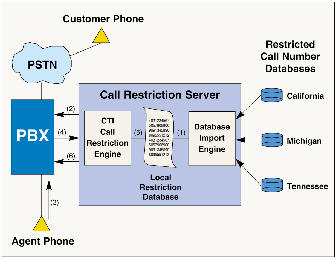
September 1999
How CTI Can Solve The Call Restriction Dilemma
BY SANJAY MEHTA AND DEAN ALLEVA, ELOQUENT COMMUNICATIONS, INC.
So you've resolved your Y2K issues and are prepared for a smooth transition to the new
millennium. Just when things seem to be on track again, government regulations are about
to create a new dilemma for telemarketers. Throughout the country, state legislation is
placing new restrictions on telemarketing calls, including who can be called and when
calls can be made. Many PBX and call center products do not currently provide outbound
call restriction functionality and both PBX vendors and call center managers are
scrambling to meet the looming deadlines. As we will see, PBX and call center system
providers are using two approaches to provide calling restriction capabilities. Here is a
summary of some of the pending legislation in 1999 (for a more detailed description, see
"1999 State
Legislation For Telemarketers" by Jerry Cerasale in the June 1999 issue of C@LL
CENTER Solutions™).
Arkansas - A statewide database of restricted telephone numbers is to
be provided by the state attorney. Telephone marketers have 10 days to update their lists
whenever the state's database is modified.
California and Michigan - These states will have do-not-call lists
containing numbers of subscribers who do not wish to receive unsolicited calls.
Minnesota - A pending measure prohibits calls between 5:30 p.m. and
7:30 p.m.
Tennessee and South Carolina - Both states are establishing statewide
databases of restricted numbers.
In addition, many states are also passing legislation which requires telephone
marketers to provide full, unmodified caller ID information and prevent any form of caller
ID blocking for unsolicited sales calls. Given the changing face of legislative measures
across the country, PBX vendors, call center solutions providers and call center managers
are faced with dilemmas on how to provide the most flexible and timely solutions.
To solve these legislative requirements, PBX vendors are taking two approaches. First,
there is the in-the-skin solution which places the call restriction capability within the
PBX. This approach has the obvious advantage of providing a seamlessly integrated
solution, but there is at least one hidden issue. Most states will be providing access to
a centralized database of restricted numbers and these data must be imported into the PBX.
Although the process can be done manually, this would be a time-consuming and error-prone
task. An alternative approach is to provide an external software solution which will act
as a gateway, converting the state's call list and importing these data into the PBX.
Since each state will be providing a slightly different mechanism, installations in each
state will require some level of customization. In addition, call centers that call
interstate will need to import data from multiple state databases, greatly increasing the
complexity of the import function.
The second approach to resolving the calling restriction dilemma is to use
computer-telephony integration (CTI) as a method of restricting outbound calling. This
solution has the advantage of being easily expandable to meet future requirements. This
approach requires the development of an external application which uses the PBX's CTI link
to monitor outbound calling and restrict (disconnect) calls as necessary. The application
should provide both an import function similar to that for an in-the-skin solution and the
actual restriction function.
The level of CTI functionality re-quired from the PBX is relatively low and is comprised
of three functions:
- The ability to monitor phone devices used for outbound calling. This is a basic
CTI functionality usually provided by all vendors.
- The ability to receive notification when a phone originates a call. Often
termed the "originated event," this message contains the number which is being
dialed.
- The ability to disconnect the call if the number is restricted. The key here is
that the call must be disconnected before the destination starts ringing. As a general
rule, the application should be able to process the originated event, search the database
to see if the called number is restricted and disconnect the call in less than three
seconds.
Given a PBX system with this level of CTI capability, a solution can be provided via an
external application platform. This solution should provide both the call restriction
functionality and the import capability in a single, integrated package. As with the
in-the-skin solution, installations in each state will require varying degrees of system
integration and customization. Any call center operating across multiple states and time
zones will have to take into account specific state restrictions and time differences.
Figure 1 shows an example of a CTI configuration including database import from multiple
states.
In the figure, the following steps are indicated:
- Local restriction database is built based on one or more state databases.
- Via CTI link, the call restriction server monitors agent phones.
- Agent dials customer number.
- Originated event is delivered to the call restriction engine.
- Call restriction engine checks the database to see if the number is restricted.
- If the number is restricted, the server sends a disconnect request to the PBX to
disconnect the call.
PBX vendors, call center system providers and call center managers need to move quickly
to meet the impending legislative deadlines. CTI can provide the needed functionality in a
timely fashion. If your call center needs call restriction capabilities, make sure the
solution provider has a strong systems integration background and an understanding of
current and pending legislation. The key is to get a solution that can be modified and
expanded to meet future legislative requirements.
Sanjay Mehta and Dean Alleva are principals of Eloquent
Communications Inc., an applications development and systems integration company based
in Southern California. Eloquent provides consulting, development and integration services
to telecom, CTI and e-commerce vendors as well as end users.
Figure 1 [return to text] |